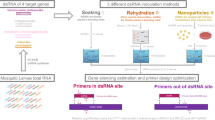Summary
Piry virus was found to multiply inAedes aegypti mosquitoes and in cell cultures ofAedes aegypti andAedes albopictus. The virus was demonstrated in sections of brain of infected baby mice, and in BHK21 andA. albopictus cell cultures by electron microscopy. In sections of infected cells the virus is seen as bullets measuring 155 × 62 mμ, budding from membranes of endoplasmic cysterns or marginal cytoplasmic membranes. The virus was propagated in BHK21 cell cultures, concentrated, and purified by ultracentrifugation by pelleting or continuous flow into density gradients. Negatively stained preparations of such concentrates exhibit predominantly spherical and disc-shaped particles. Bullet-shaped particles are rarely found. Such preparations have nevertheless high viral titers and it is suggested that the bullets separate into spheres and discs. The separation appears to be enhanced by storage, by repeated freezing and thawing, and by foaming of the virus suspension. This phenomenon as well as the ultra-structure is being investigated further.
Similar content being viewed by others
References
Taylor, R. M.: Complete catalogue of arthropod-borne viruses of the world. A collection of data on registered arthropod-borne animal viruses. USPHS Publication No. 1760. Government Printing Office, 1967.
Bhatt, P. N., andF. M. Rodriguez: Chandipura: A new arbovirus isolated in India from patients with febrile illness. Indian med. J. Res.55, 1295–1305 (1967).
Murphy, F. A., A. K.Harrison, and S. G.Whitfield: The infection of cells by bullet-shaped viruses. Proc. EMSA, 27th Annual (1969).
Peleg, J.: Growth of arboviruses in monolayers from subcultured mosquito embryo cells. Virology35, 617–619 (1968).
Singh, K. R. P.: Continuous cell cultures derived from larvae ofAedes albopictus (Skuse) andAedes aegypti (L). Current Sci. (India)36, 506–508 (1967).
Bergold, G. H., andR. Mazzali: Plaque formation by arboviruses. J. gen. Virol.2, 273–284 (1968).
Bergold, G. H., O. M. Suarez, andK. Munz: Multiplication in and transmission byAedes aegypti of vesicular stomatitis virus. J. Invert. Path.11, 406–428 (1968).
Bergold, G. H., L. A. Gonzalez Marquez, R. Mazzali, andK. Munz: Structure of nine arboviruses. J. gen. Virol.5, 135–140 (1969).
Bergold, G. H., andR. Mazzali: Problems using density gradients. Arch. ges. Virusforsch.31, 168–174 (1970).
Kohn, J.: A simple method for the concentration of fluids containing protein. Nature183, 1055 (1959).
Jamison, R. M., andH. D. Mayor: Comparative study of seven Picorna viruses of man. J. Bact.91, 1971–1976 (1966).
Buckley, S. M.: Susceptibility ofAedes albopictus andAedes aegypti cell lines to infection with arboviruses. Proc. Soc. exp. Biol. (N.Y.)131, 625–630 (1969).
Anderson, N. G., andG. B. Cline: New centrifugal methods for virus isolation. In: Methods in Virology, Vol. II, pp. 137–178. Ed. K. Maramorosch and H. Koprowski, New York and London: Academic Press, 1967.
Author information
Authors and Affiliations
Additional information
Dedicated to Professor Dr. Dr. C.Hallauer on the occasion of his 70th birthday.
Rights and permissions
About this article
Cite this article
Bergold, G.H., Munz, K. Characterization of piry virus. Archiv f Virusforschung 31, 152–167 (1970). https://doi.org/10.1007/BF01241673
Received:
Issue Date:
DOI: https://doi.org/10.1007/BF01241673




